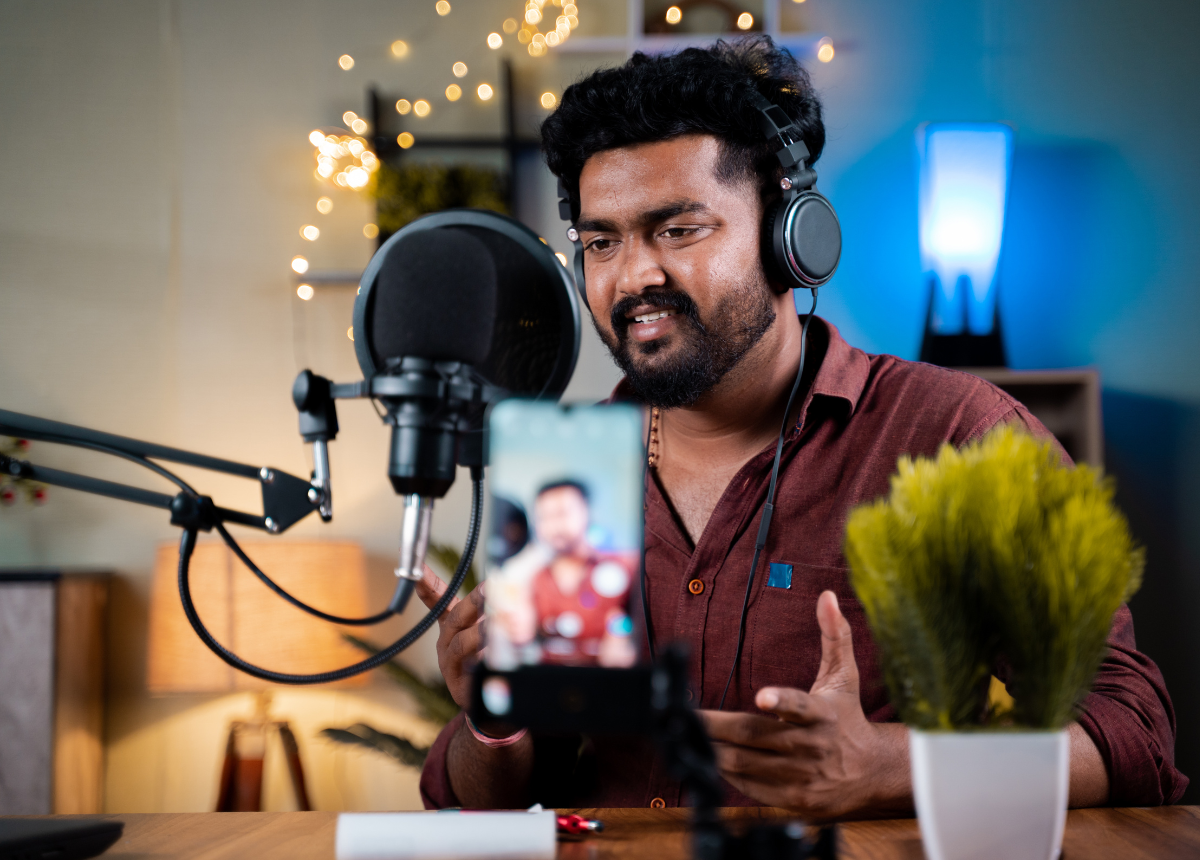Why influencers are the ultimate connector of integrated communications

The digital landscape is crowded with social media channels designed to entertain, inform and distract audiences — leaving brands struggling to cut through the noise. How do you approach this highly saturated landscape? One proven marketing strategy is leveraging social media influencers to drive awareness and engagement.
Data shows that 53% of adults say they get important news from social media, while 73% of adults also see social networks as entertainment and 51% of consumers read reviews on forums or social media to evaluate a product before purchasing. So clearly social media needs to be part of an integrated communications strategy.
That's as true for B2B marketing as it is for consumer marketing: According to Gartner, 40% of B2B buyers rely on social media to inform their purchase decisions, which is why B2B marketers are devoting an average of 12% of their marketing budgets to social media programs.
Influencer marketing can help you unlock the power of social media and supercharge your integrated communications strategy.
The evolution of social media influencers
Before the internet, it was no easy task to physically seek out friends and trusted local experts for advice on what to buy, or sort through endless lists of businesses to find just what you were looking for. Remember the Yellow Pages? A novel idea in its day – the tagline was, “Let your fingers do the walking.” The Yellow Pages showed consumers that it’s easier to get recommendations from a trusted source than to dig around doing your own research and the same is still true today. But instead of breaking out the phone book, it happens on social media. Today, it may as well be “Let your fingers do the scrolling.”
This is obvious in the consumer realm -- many people like to learn more about using a beauty product or home improvement tools, while others seek serious lifestyle advice from those in the financial and health sectors. Consider Financial Tiktok or #FinTok. This hashtag alone has 3.6 billion views and counting, with feeds flooded with resources on everything from saving for retirement to navigating gig work on your taxes, particularly popular among younger audiences who increasingly seek answers via TikTok instead of traditional search engines.
On the B2B side, just look at how many people are posting about generative AI, digital transformation, or hybrid work on LinkedIn. For the most successful influencers on these topics, post views are in the thousands and comments in the hundreds.
So, how do you find and partner with the social media influencers who are most relevant to your marketing and communications goals?
Diving deeper into the advantages of influencer marketing
While you must meet your audience where they are online, the most successful brands go above and beyond. They provide the information consumers seek while providing something extra — whether it's a source of entertainment or a thought-provoking campaign.
Finding that balance between being useful and entertaining or emotionally moving isn't easy. This approach can also be challenging concerning your brand voice and potential constraints. In these cases, a helping (influential) hand can cause your key social media metrics to skyrocket.
Social proof is everything, and influencers are integral to integrated communication strategies. These individuals have influence and power in social media, so their audience listens when they promote products and services. The results can be incredible when that audience aligns with your brand's values and likes what you offer.
One thing that differentiates influencers from news media is the level of interactivity they have with their audiences. Influencers thrive on engagement, and their audiences adore them. This makes them especially effective at communicating brand values, making recommendations and creating call-to-actions (CTAs) that will help you boost conversions.
The best influencer marketing campaigns, whether consumer-focused or B2B, are those that leverage the strengths of those relationships: authenticity, interactivity, and personality.
Why work with influencers?
Social media influencers often work with brands via paid engagements. Just like an advertising media placement, the buyer and the influencer negotiate terms and outcomes, create a contract, and commit to certain results. Taking this approach means that outcomes are measurable, helping brands better understand the value of these partnerships concerning key metrics. Ultimately, the goal is to improve a campaign's ROI.
For some, that may mean increased brand reach, while others seek measurable impacts on specific customer actions, like higher click-through rates. CTAs are directed based on the influencer, audience and subject. However, since these influencers deliver these CTAs with passion and relevance, they come across as natural and authentic — something consumers are increasingly mindful of.
When influencers are under contract, they will follow the key messages you want them to deliver, meaning this is a highly controlled and brand-safe channel for reaching your market. However, not all social media influencer activity is created equal. There are different types of engagements, each offering key advantages and disadvantages.
No. 1 : Organic, unsponsored influencer content
These influencer mentions are not prompted. Sometimes you get lucky, and an influencer just starts talking about you. Great! Or, maybe not so great.
Pros
- Free
- Sometimes viral
- Often highly relevant to the audience
Cons
- While you or an agency can pitch ideas, it's impossible to plan, predict or measure
- No direct link to the brand limits based on CTA opportunities
- Sometimes inaccurate, with no easy recourse to correct it
No. 2: Traditional sponsorship
For influencers that accept sponsorships, this is an easy win. You create a sponsor message and the influencer puts it into ready-made sponsorship slots.
Pros
- Fast and simple: You give them money, they mention the brand
- Predictable reach
- Contracted and guaranteed placement
Cons
- The brand is usually mentioned passively (once or twice and not integrated into regularly scheduled content)
- The audience is not engaged with the brand through shared purpose or CTA
- This approach can be difficult to measure (awareness without action isn't useful)
No. 3: Paid partnerships
This leading option involves clear, creative storytelling with authentic delivery and measurable results.
Pros
- Contracted and guaranteed placement
- Ability to create consistent messaging across channels
- Influencer-specific UTMs for measuring referred traffic
Cons
- Cost
While it's true there's a monetary cost for paid partnerships, and it can be higher than for traditional sponsorships, this is the most effective approach for achieving impact, including improved conversions and ultimately will deliver a higher ROI.
With paid partnerships, you maximize the authenticity of the influencer with original content, tailored to your brand and perfectly suited for their audience. You get measureable results and immediate impact. This strategy can be deployed quickly and with reduced risk across both large and niche audiences. And when managed correctly, this level of engagement can connect brands with audiences in a safe, authentic, and scalable way.
Influencer marketing applications
Brand building benefits from authentic content, especially when you meet your audiences where they are, across all channels.
Authenticity is where influencers excel. But they aren't always well positioned to work optimally with every brand. There may be hundreds or thousands of influencers that may be relevant to your brand and could potentially have a significant impact. Working with an agency can help you identify the optimal influencers, take strategic communications to the next level and build smarter campaigns that might leverage many different influencers to build a bigger, more impactful audience.
Agencies like Highwire create collaborations in ways that are true to the brand, the influencer, and the influencer's audience. That alignment helps drive results and grow followers -- with authenticity.
For example, there is often a cross-over between sustainability and fashion. When you embrace crossover opportunities, targeting people in new (yet related) areas, you can expand your audience while the influencers grow their followers. Everyone wins in this type of collaboration.
The brand brings your product or service to the table, the influencer brings their audience and digital power, and the audience gets a great recommendation and valuable info from a source they trust.
This high-converting cycle all comes together with sound messaging through:
- Consolidated content plans
- Constant message reinforcement
- Measuring success through shared metrics
How Highwire PR can help
Influencers are an optimal solution if you are trying to reach new audiences, grow your following and drive conversions. These impactful individuals allow you to reach audiences with special interests, providing the reach and credibility to engage them — and at scale.
Best of all, each campaign and social media influencer is highly trackable. Whether it be CTAs from link clicks, comments, or sign-up forms, you measure what matters with this approach. Data-driven insights help fuel results, allowing you to build on the program's success, and the element of repeatability through strategic partnerships and performance benchmarking is often the golden ticket.
Want to learn more about how Highwire PR can elevate your communication strategy through our integrated services, including influencer marketing? Contact us today — we'd love to chat about your brand and influencer marketing opportunities!
